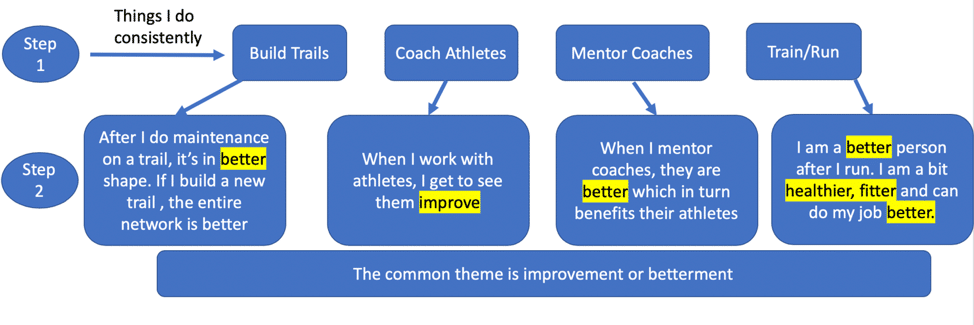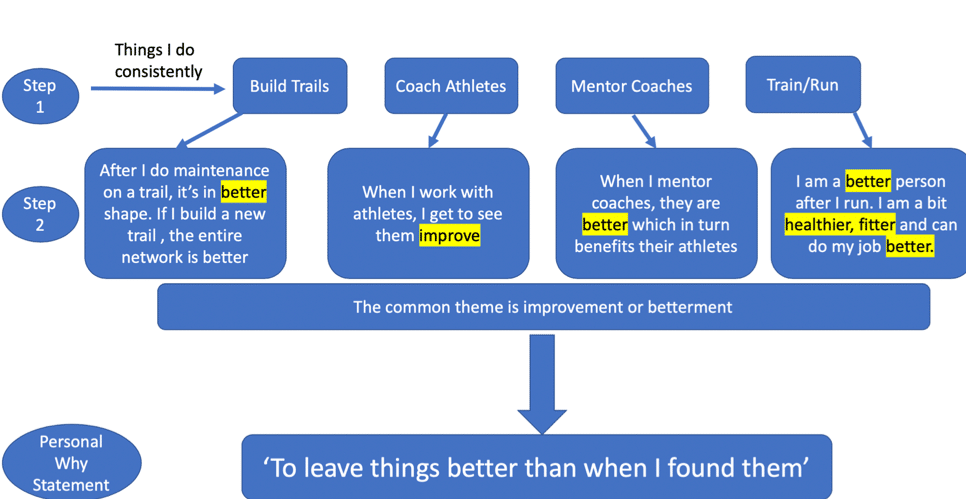
Reconnect to Your WHY to Reinvigorate Your Runs
By Jason Koop,
Head Coach of CTS Ultrarunning
I recently have noticed two types of ultrarunners emerge. The first is the ultrarunner who’s training is lacking something. Maybe it is the length of your long runs or maybe it’s the second hard interval session of the week. These ultrarunners are training in a fog at the present. They can’t see past their own nose much less what to do when they head out the door, if they even head out at all. Without a clear goal to illuminate their path, training is inconsistent, haphazard and uninspired. They inevitably describe themselves as being ‘unmotivated’.
But there is also a subsection of athletes that I see and I work with who haven’t skipped a beat. They are still putting their heads down and training. They are clear and purposeful when they head out the door. Sure, their running has been adjusted to suit the current times, but they still hit the trails (or the treadmill) with a purpose. They will do the long runs, the hard runs, the easy runs and everything in between. Yet, like the former group, some athletes in this category will also say they are unmotivated. Still, they forge on and continue to motor down the well lit path in front of them.
So what is the difference between the two groups? Both have ambiguous or outright cancelled seasons. Both could label themselves as ‘unmotivated’. Both will have similar restrictions on their access to trails, the gym, training partners and toilet paper. They seemingly have similar situations, restrictions and opportunities available. So what drives the latter group forward when the former is seemingly suck in training quicksand? The latter group has a strong WHY that connects them to training. Their WHY is not a race, motivation, or even love. While these can be powerful, all will come and go, some with no particular rhyme or reason. Races, as we now have come to learn, can be taken away in an instant. Motivation can ebb and flow. And let’s face it, you don’t always love running. A runner’s WHY is omnipresent. It can drive us regardless of suit or circumstance. It’s a deep sense of purpose and connection that cannot be severed by something as trivial as a local trail closure or cancelled race. And as I will show you through a personal example, it will even transcend running.
Outside of the running world, we see people with strong WHYs right now. They are the frontline healthcare workers that sacrifice personal health and safety for the greater good. They are infectious disease specialists who are poring over mountains of data, indifferent to their own sleep and wellbeing. These individuals are driven by a purpose deeper than motivation and love. They have a strongly connected WHY to their actions. It is because of this connection that they forge on with conviction. If you have lost, or never had your WHY in the first place, don’t fret. Now is a great time to reconnect, reinforce, or discover your personal WHY, and I’m going to show you how.
(Author’s note- The following framework I have adapted from Simon Sinek’s work, which is discussed in far greater and more eloquent detail in his book Start With Why)
Step 1- Write down all the things you do consistently
Although life might contain very few consistencies as of late, my guess is that you still do some meaningful things on a consistent basis. Your first step in developing your individual WHY is to take an inventory of the things that you voluntarily do on a regular basis. ‘Getting out of bed’ and ‘fixing dinner for the kids’ are noble but won’t quite cut it at this stage. Think of the things you look forward to, don’t procrastinate and derive satisfaction from, even when no one will give you the credit. Don’t try to assign meaning to them just yet, just get them down on paper. Below is a redacted brainstorm of what I did personally for this exercise a couple of years ago. I know that without fail I will run, coach, mentor other coaches and build and help maintain trails here in our local area. At the time I did this exercise, I actually had no idea why I would do these consistently without much prompting. Yet, I’d do them nonetheless. My guess is that many of you reading this blog will have ‘running’ as one of those things. If it is, then great. If not, don’t be pretentious, this is just step one in the means to the end.

Step 2- Find the threads that are intertwined with your actions
Your next step in reconnecting your personal why is to find all of the interconnected threads between your individual actions. This next step will take a while, so be patient. When personally working through this exercise, it took me about a month to fully vet this stage. Set aside some time every week to flesh through themes that all, or at least most, of consistent actions have in common. Recruit your friends and training partners to help you with this exercise (via Zoom, of course). Avoid the simple truisms like ‘they make me feel good’, ‘it’s motivating’ or ‘I love it’. Dig deeper than superficial feelings and emotions which will come and go. In my example, it was clear to me that after working on a trail, mentoring a coach, or going for a run that something or someone was better than before. The themes of ‘betterment’ and ‘improvement’ started to resonate with me (as highlighted below).

► Free Ultrarunning Training Assessment Quiz
Take our free 2-minute quiz to discover how effective your training is and get recommendations for how you can improve.
Step 3- Craft your personal WHY
From your interconnected threads, it’s time to craft your personal WHY. Keep it at one sentence and stick to the point. While you will have many interconnected themes between your consistent actions, choose the one (two at the most) that are the most powerful. This is not a time for A, B and C plans. After all, the exercise is to reconnect your singular WHY, not WHYs. For me, that WHY boiled down to ‘To leave things better than when I found them’. Yes, it’s something many of have heard hundreds of times and it is admittedly a bit cliché. But that’s fine because it resonates with me. I can go for a run, work on a local trail, help out a coach or athlete and know that at the end of the day, whatever I have acted upon will be better because of the effort.
Enjoying This Article? Get More Free Running Training Tips
Get our coaches' best training advice, delivered straight to your inbox weekly.

Step 4- Reconnect your WHY
OK great, you have this meaningful statement, meaning you can yell it as a motivational battle cry while you triumphantly hammer down the trails on your next run? Nope, it’s not that simple. To paraphrase ultrarunning badass and former Navy SEAL David Goggins, ‘Motivation is bulls*!t’. If you think you will come to the end of this exercise and somehow have a magic motivator, you’ve missed the point. Motivation, just like your postponed race or closed trailhead, will come and go, and that’s fine. Your WHY is a constant and your opportunity now is to reconnect your WHY with other areas of your life, including running. If you got to your WHY by having running being one of your constant actions, then great; this connection should have already been established. But, if the path is not as clear, that’s fine. Remember, your WHY transcends running. It should be naturally woven into many areas of your life, not forced like the preverbal round peg in the square hole. If the connection to running is strong, my guess is that training has changed very little for you in the last several weeks. It is OK if that connection is not as strong. Running can take more of a back seat and you don’t have to beat yourself up over it because you understand you have stronger connections elsewhere. And, as I wrote about earlier this month, your training and fitness will be fine!
If the result of cancelled races and MIA training partners is that your running is stuck in a rut, take it as a sign you need to go through this exercise. Understanding your deeper connection to running, and other areas of your life, through a personal WHY will help you to make sense of it all. And, making sense out of how you feel, act and react in today’s uncertain world is valuable all by itself.


Comments 7
Pingback: Training Burnout: Prevention, recovery, and how it's different from Overtraining - CTS
Pingback: 3 Steps to Make the Most of Your 2020 Ultramarathon Training - CTS
Pingback: Stuck in a run training rut? Do this workout today. - Jason Koop
As always, excellent information, well written and of course very timely in these difficult times. Keeping my athletes engaged and motivated has been the biggest challenge. And as you know best, no 2 athletes are the same or even use the same training plan.
Keep them coming Jason
i thought I was the only one unmotivated.
This is probably the most fundamentally important, practical and useful post in the ultrarunning community all year, and especially at this time. Thank you Jason for taking the time to help us each find, and connect with, our North Star. #BurnBright
Jason — As a serious cyclist for more than half a century as well as a professional identity consultant and marketing lecturer at Johns Hopkins School of Public Health, I couldn’t agree more. At 70 last year I won my age group in 12 and 24 hour races at the national level…and it was NOT because I do a lot of HIIT. I teach my students a method very similar to yours and have used it to help “brand” several for-profit and non-profit organizations. Over the years, I’ve trained thousands of folks (athletes and not) in it. In 2016, after riding cross country in 18 days (averaging 150 miles a day), I published “Getting UP! Supercharging Your Energy” to provide more detailed advice and examples. Whether you’re trying to get through Dirty Kanza, Paris-Brest-Paris, or COVID, the REAL power comes from within!